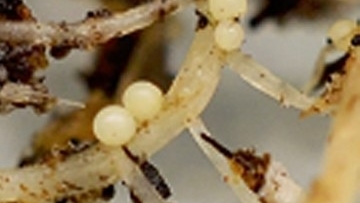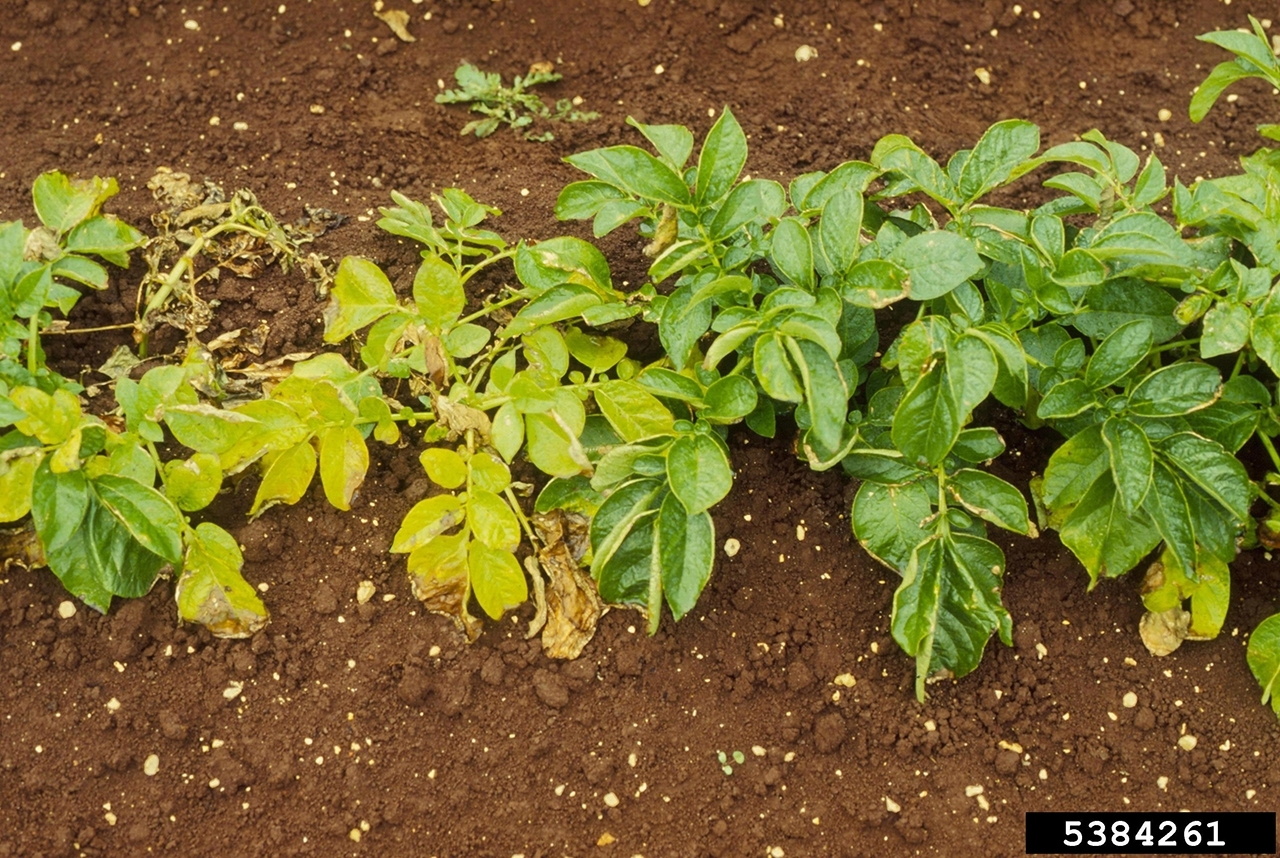Pale Cyst Nematode

LM Dandurand, University of Idaho
The pale cyst nematode (Globodera pallida, PCN) is a soil-dwelling roundworm that feeds on the roots of high-value crops such as potatoes, tomatoes, and eggplants. PCN is native to South America and was discovered in Idaho in 2006. This pest can remain dormant and viable in soil for 30 years.
PCN are microscopic cyst-forming nematodes. When a mated female dies, her body hardens and becomes a cyst that contains between 300 to 500 viable eggs. If PCN populations are left unchecked, they can reduce crop yields by 20 to 70 percent.
When PCN is detected, it stops commerce in potatoes and nursery stock. It can seriously harm our agricultural production, environment, and economy. Here's what to look for:
- Cysts
- Dead females (cysts) can be found on the roots and potato tubers. They can stay dormant for up to 30 years, while the eggs inside remain viable.
- Field damage
- Stunted plants with yellowing leaves, wilting, and eventually plant death.



Female Globodera pallida on a root. You can also see a brown cyst (dead female) on the same root.
Bonsak Hammeraas, NIBIO - The Norwegian Institute of Bioeconomy Research, Bugwood.org
Potato plants in the field showing signs of Globodera pallida.
Florida Division of Plant Industry, Florida Department of Agriculture and Consumer Services, Bugwood.org
Sign of Globodera pallida on potato.
Florida Division of Plant Industry, Florida Department of Agriculture and Consumer Services, Bugwood.org
PCN spreads when soil from an infested field is moved to a new location on farming equipment, seed potatoes, or waste from potato grading operations. All farming equipment used on infested land must be pressure washed to remove soil. Equipment with difficult to reach areas, such as harvesters, may need to be steam treated or fumigated to ensure it is nematode-free. Pressure washing and steam treatments are coordinated through APHIS.
To prevent the spread of PCN:
- Make sure all farm machinery, trucks, construction, and other equipment are clean when going from field to field. Do not allow any equipment in your fields unless it has been thoroughly cleaned. This is especially important when renting land, as you may not have records of previous crop history.
- Check the condition of trucks and other vehicles entering your operation. Find out where they have been and what sanitation treatments they have had. Seed potato shipments are a particular concern for PCN spread because trucks may make more than one stop.
- Do not spread waste from potato grading, processing, or storage operations on farmland or place it in an area where it can be spread to farmlands.
- Leave hedgerows, sod barriers, or sod strips between fields and along highways.
- Buy only certified seed that comes from fields tested and found to be PCN-free.
- Plant a PCN-resistant variety (if available) in your noninfested fields at least once every 4 years.
- Plant cover crops as soon as possible when land is not in use because wind and water erosion can spread PCN cysts.
- Tell people in your operation about the seriousness of PCN and potato diseases. Make sure they follow all precautions. Provide equipment needed to conduct proper cleaning and disinfection procedures.
- Segregate potatoes in storage by field.
- Do not reuse previously used bags or containers for potato transport. Be sure all commercial transport vehicles are free of soil.
- Do not allow temporary help, custom applicators, or utility companies to bring their vehicles onto your farmland without proper cleaning. Do not allow them to bring any bags or containers with them to the field.
- Do not use common headlands, farm roads, and public roads as turning areas.
- Prohibit nonauthorized entry onto farmlands using “No Trespassing” signs.
- Do not assume that nonregulated fields are free of PCN.
PCN-infested fields are treated with a chemical fumigant in late summer or early fall and sometimes in early spring, depending on soil temperature. These treatments continue until PCN is eradicated. APHIS monitors eradication progress.
Report Plant Pests and Diseases
Have you seen this pest or signs of pest damage? Immediately report your findings.
Find your State plant regulatory official
Find your State plant health director
Controlling Pale Cyst Nematodes
APHIS has successfully contained PCN to an 8.5-mile radius area in southeast Idaho, preventing its spread to other potato-producing areas in the United States.
Quarantine Information
State Plant Regulatory Official (SPRO) Letters
- Update to Regulated Area in Idaho (June 13, 2025)
- Removal of Regulated Area in Idaho (100.43 KB) (February 26, 2025)
- Amendment of Regulated Area in Idaho (95.81 KB) (August 12, 2024)
- Removal of Regulated Areas in Idaho (91.57 KB)(November 27, 2023)
- Removal of Regulated Areas in Idaho (360.5 KB)(February 3, 2023)
- Removal of Regulated Areas in Idaho (93.5 KB) (June 6, 2022)
- Addition of Regulated Areas in Idaho (118.94 KB) (January 18, 2022)
- Removal of Regulated Areas Idaho (96.28 KB) (January 11, 2022)
- Removal of Regulated Areas in Idaho (121.14 KB) (August 13, 2021)
- Addition and Removal of Regulated Areas in Idaho (106.41 KB) (March 19, 2021)
- Addition of Regulated Areas in Idaho (104.15 KB) (January 17, 2020)
Description of Changes
The following documents describe changes to the PCN-regulated areas, including field maps and an explanation of the changes by date.
- June 13, 2025
- November 13, 2024
- August 12, 2024
- November 16, 2023
- January 11, 2023
- April 20, 2022
- November 29, 2021
- November 22, 2021
- July 13, 2021
- January 28, 2021
- January 10, 2020 Description
- January 10, 2020 Map
To request copies of archived quarantine information documents, email us at aphisweb@usda.gov.
APHIS conducts a containment program for PCN directed toward eradication. The PCN program’s overarching goals are to prevent the spread of PCN, delimit the infestation, eradicate the pest, and preserve domestic and foreign markets. States also conduct annual PCN surveys.
Program-Associated Field Survey and Laboratory Result Definitions
| Term | Definition |
|---|---|
| Baseline Survey | A full‐field survey at a sampling rate of 8,000 cc of soil per acre (equivalent to approximately 20 pounds of soil per acre) used to determine the presence or absence of PCN. The baseline survey is conducted as soon as practicable upon becoming regulated as an associated field when the field is not eligible to receive the first delimiting survey towards deregulation (eligibility requires at least one host crop grown and harvested from the field since the time of exposure to soil from an infested field). |
| Delimiting (Delimitation) Survey | A full‐field survey at a sampling rate of 8,000 cc of soil per acre (equivalent to approximately 20 pounds of soil per acre) used to determine the presence or absence of PCN. A series of two negative delimiting surveys, each following harvest of the next two host crops grown on the field, is required to deregulate an associated field. |
| Follow-up Survey | A full‐field survey used to determine the presence or absence of PCN in fields where laboratory results are inconclusive for PCN, suspect for PCN by morphological/morphometric analysis, or suspect for PCN by molecular (DNA) analysis. The deregulation requirement for fields deemed inconclusive for PCN or suspect for PCN by morphological/morphometric analysis is a series of two follow-up surveys at the delimiting survey rate, one of which must follow the next host crop grown on the field. The deregulation requirement for fields deemed suspect for PCN by molecular (DNA) analysis is a negative follow-up survey at the delimiting survey rate, following each of the next two host crops grown on the field. |
| Negative for PCN | No PCN cysts were found. |
| Positive for PCN (Infested) | The minimum threshold for declaring a field positive for PCN (infested) is met by detecting a minimum of two cysts from two samples that were identified as Globodera sp. by morphological/morphometric analysis, and at least one of the cysts was viable and confirmed as Globodera pallida (PCN) by molecular (DNA) analysis. |
| Suspect for PCN by DNA Analysis | A single cyst was identified as Globodera pallida (PCN) by morphological/morphometric and molecular (DNA) analysis; however, the minimum threshold for declaring a field positive for PCN (infested) was not met. |
| Suspect for PCN by Morphological/Morphometric Analysis | Cyst(s) from one or more samples were identified as Globodera sp. by morphological/morphometric analysis. No viable, DNA‐containing material was found inside the cysts, so a definitive identification as Globodera pallida could not be made. |
| Inconclusive for PCN | Object(s) resembling Globodera sp. cysts were found in a soil sample(s); however, a definitive identification could not be made using either morphological/morphometric analysis or molecular (DNA) analysis. Some morphological characteristics of Globodera sp. were present such that PCN could not be ruled out. |
Confirmations and Deregulatory Actions
- Infested Field Confirmation Policy
- Deregulation Protocols
- Changes to Regulated Areas (archived documents available upon request)
- Removal of Regulated Areas in Idaho (November 27, 2023)
- Removal of Regulated Areas in Idaho(February 3, 2023)
- Removal of Regulated Areas in Idaho (June 6, 2022)
- Addition of Regulated Areas in Idaho (January 18, 2022)
- Removal of Regulated Areas Idaho (January 11, 2022)
- Removal of Regulated Areas in Idaho (August 13, 2021)
- Addition and Removal of Regulated Areas in Idaho (March 19, 2021)
- Addition of Regulated Areas in Idaho (January 17, 2020)
Federal Register Notices
- September 16, 2016 (188.88 KB), Update of Quarantined Areas
- September 8, 2010 (52.37 KB), Notice of Changes to Quarantined Area
- July 10, 2009 (48.35 KB), Notice of Changes to Quarantined Area
- May 7, 2009 (50.49 KB), Notice of Changes to Quarantined Area
- April 29, 2009 (90.13 KB), Final Rule
- April 10, 2009 (50.49 KB), Update of Quarantined Areas
- September 11, 2008 (49.57 KB), Update of Quarantined Areas
- June 6, 2008 (52.11 KB), Update of Quarantined Areas
- September 12, 2007 (120.36 KB), Interim Rule and request for comments
PCN Regulations
- Potato Cyst Nematode Guidelines : These guidelines outline the surveillance and phytosanitary actions used to detect and manage PCN (updated May 7, 2014).
- Self-Sanitation Tracking Form, available as .docx, .pdf, and .xls
- Potato Cyst Nematode National Survey Plan: “Looking” To Keep Potato Markets Open (2.98 MB) (brochure, May 2015)
- Pest Alert: Potato Cyst Nematodes (1.08 MB) (May 2015)
Program Review
- Five-Year Review: Idaho Falls, ID (March 2012)
Program Updates
- 2024, Third Quarter
- 2024, Second Quarter
- 2024, First Quarter
- 2023, Fourth Quarter
- 2023, Third Quarter
- 2023, Second Quarter
- 2023, First Quarter
- 2022, Fourth Quarter
- 2022, Third Quarter
- 2022, Second Quarter
- 2022, First Quarter
To request copies of archived program updates, email us at aphisweb@usda.gov.




